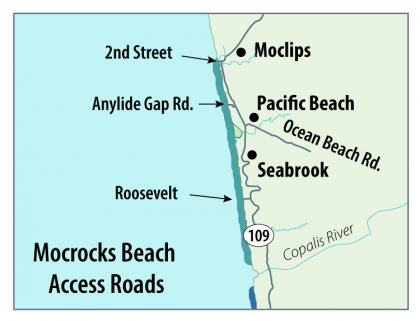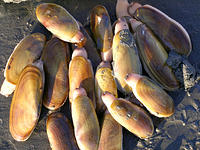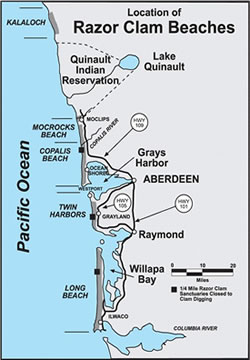WDFW Approves razor clam tides: May 10th- May 15thTides Last tides of the season. Halibut Season Starts May 1st Bottom Fishing opens March 8th
- Home
- Razor Clam Tides
Razor Clam Tides

WDFW Approved Razor Clam Tides:
The following digs during evening (P.M.) low tides will proceed as scheduled, after marine toxin results from the DOH showed razor clams are safe to eat.
- Oct. 20, Monday, 6:40 p.m.; 0.2 feet; Long Beach, Twin Harbors, Copalis
- Oct. 21, Tuesday, 7:13 p.m.; -0.1 feet; Long Beach, Twin Harbors, Copalis
- Oct. 22, Wednesday, 7:45 p.m.; -0.3 feet; Long Beach, Twin Harbors, Mocrocks
- Oct. 23, Thursday, 8:18 p.m.; -0.3 feet; Long Beach, Twin Harbors, Mocrocks
- Oct. 24, Friday, 8:53 p.m.; -0.1 feet; Long Beach, Twin Harbors, Copalis
- Oct. 25, Saturday, 9:31 p.m.; 0.1 feet; Long Beach, Twin Harbors, Copalis
- Oct. 26, Sunday, 10:15 p.m.; 0.5 feet; Long Beach, Twin Harbors, Mocrocks

Clam Gun or Shovel
Check this out!
WDFW wants razor clam fans around the state to weigh in on the perennial question:
Which is better, clam gun or shovel?
To register support for a favored digging method, clam diggers can post a photo or video, complete with hashtag #TeamClamShovel or #TeamClamGun on any social media before the end of the spring season.

Many ocean beaches are open to motor vehicles, but drivers are required to follow the "rules of the road," said Ayres. “Mocrocks beach only has three points of road access, so we are asking beachgoers to arrive early and exercise good judgment when accessing the beach,” he added.
"Under state law, all vehicles - and horses - are required to travel along the extreme upper limit of the hard sand," he said. "When in doubt, follow the path marked by multiple tire tracks." Drivers who veer from that path pose a direct threat to fish and wildlife, Ayres said. Motorists who violate Washington state laws on beach driving can face a fine of $150, or much more for killing endangered seabirds, like snowy plovers.
“We manage recreational clam digging in Washington in a manner that we believe minimizes potential impacts to vulnerable ground nesting listed bird species,” said Ayres. “We do this by not scheduling digging after May 15 at key breeding areas for snowy plovers and streaked horned larks, including Long Beach and Twin Harbors.”
The agency continues to emphasize ‘digging while distancing’ and masking up when near others to support efforts by community health experts to ensure a fun and safe razor clam season.
The agency continues to emphasize ‘digging while distancing’ and masking up when near others to support efforts by community health experts to ensure a fun and safe razor clam season.
All diggers age 15 or older must have an applicable fishing license to harvest razor clams on any beach.
Licenses, ranging from a three-day razor clam license (starting at $9.70) to an annual combination fishing license, are available on WDFW's website and from some 600 license vendors around the state.
Under state law, diggers at open beaches can take 15 razor clams per day and are required to keep the first 15 they dig. Each digger's clams must be kept in a separate container.
Razor Clams

Please remember to check with Washington Department of Fish and Wildlife for last minute changes to the razor clam digging , rules and regulations.
Beaches in Washington with razor clam fisheries include:

Copalis Beach, which extends from the Grays Harbor north jetty to the Copalis River, and includes the Copalis, Ocean Shores, Oyhut, Ocean City and Copalis areas.
Mocrocks Beach, which extends from the Copalis River to the southern boundary of the Quinault Reservation near the Moclips River, including Iron Springs, Roosevelt Beach, Seabrook, Pacific Beach and Moclips.
Twin Harbors Beach, which extends from the mouth of Willapa Bay north to the south jetty at the mouth of Grays Harbor.
Long Beach, which extends from the Columbia River to Leadbetter Point.
Kalaloch Beach, which extends from the South Beach Campground to Brown’s Point (just south of Beach Trail 3) in the Olympic National Park.
WDFW announces 47 tentative days of coastal razor clam digging opportunities beginning Oct. 6
News release Sept. 9, 2025
Contact: Bryce Blumenthal, 360-249-1207
Media contact: Mark Yuasa, 360-902-2262
OLYMPIA – Shellfish managers with the Washington Department of Fish and Wildlife (WDFW) today announced 47 tentative days of razor clam digs at four coastal beaches from Oct. 6 through Jan. 6.
"This recreational razor clam season will see similar digging opportunity to the past two years, with a full digging schedule again for this fall,” said Bryce Blumenthal, a WDFW coastal shellfish biologist. “The tides this year will allow for clam gathering opportunity in the lead up to the Thanksgiving and Christmas holidays, along with harvestable daylight digs for the late afternoons of New Year’s Eve and New Year’s Day.”
All beach openings are dependent on final approval of marine toxin testing, which usually occurs about a week or less before the start of each digging series. Before a beach can open for digging, the Washington State Department of Health (DOH) requires two test samples seven to 10 days apart and domoic acid levels under the guideline level.
Domoic acid, a natural toxin that certain marine algae produce, can be harmful or fatal if consumed in sufficient quantities. For more information about domoic acid, as well as current levels at ocean beaches, refer to the WDFW’s domoic acid webpage and the DOH webpage.
On all open beaches – Long Beach, Twin Harbors, Copalis, and Mocrocks – the daily limit is 15 clams per person. Each digger’s clams must be kept in a separate container, and all diggers must keep the first 15 clams they dig, regardless of size or condition.
“It's important that diggers keep the clams they dig to prevent wastage (includes discarding small clams, clam with broken shells or reburying unwanted clams),” Blumenthal said. “It's not unusual to encounter some small clams, especially this early in the season.”
Kalaloch beach off the northern Olympic Peninsula coast won’t be open due to continuing issues with depressed populations of harvestable clams.
Most successful digging occurs between one and two hours before the listed time of low tide. Below are the tentative dates, along with low tides and beaches.
Tentative dates during late afternoon/evening (noon to midnight only) low tides:
- Oct. 6, Monday; 6:35 p.m.; -0.2 feet; Long Beach, Twin Harbors, Mocrocks
- Oct. 7, Tuesday; 7:18 p.m.; -1.0 feet; Long Beach, Twin Harbors, Mocrocks
- Oct. 8, Wednesday, 8:02 p.m.; -1.4 feet; Long Beach, Twin Harbors, Copalis
- Oct. 9, Thursday, 8:49 p.m.; -1.5 feet; Long Beach, Twin Harbors, Copalis
- Oct. 10, Friday, 9:40 p.m.; -1.3 feet; Long Beach, Twin Harbors, Mocrocks
- Oct. 11, Saturday, 10:37 p.m.; -0.8 feet; Long Beach, Twin Harbors, Mocrocks
- Oct. 12, Sunday, 11:41 p.m.; -0.2 feet; Long Beach, Twin Harbors, Copalis
- Oct. 20, Monday, 6:40 p.m.; 0.2 feet; Long Beach, Twin Harbors, Copalis
- Oct. 21, Tuesday, 7:13 p.m.; -0.1 feet; Long Beach, Twin Harbors, Copalis
- Oct. 22, Wednesday, 7:45 p.m.; -0.3 feet; Long Beach, Twin Harbors, Mocrocks
- Oct. 23, Thursday, 8:18 p.m.; -0.3 feet; Long Beach, Twin Harbors, Mocrocks
- Oct. 24, Friday, 8:53 p.m.; -0.1 feet; Long Beach, Twin Harbors, Copalis
- Oct. 25, Saturday, 9:31 p.m.; 0.1 feet; Long Beach, Twin Harbors, Copalis
- Oct. 26, Sunday, 10:15 p.m.; 0.5 feet; Long Beach, Twin Harbors, Mocrocks
- Nov. 3, Monday, 4:30 p.m.; -0.1 feet; Long Beach, Twin Harbors, Mocrocks
- Nov. 4, Tuesday, 5:15 p.m.; -1.1 feet; Long Beach, Twin Harbors, Mocrocks
- Nov. 5, Wednesday, 6:01 p.m.; -1.7 feet; Long Beach, Twin Harbors, Copalis
- Nov. 6, Thursday, 6:46 p.m.; -2.0 feet; Long Beach, Twin Harbors, Copalis
- Nov. 7, Friday, 7:34 p.m.; -1.9 feet; Long Beach, Twin Harbors, Mocrocks
- Nov. 8, Saturday, 8:25 p.m.; -1.5 feet; Long Beach, Twin Harbors, Mocrocks
- Nov. 9, Sunday, 9:19 p.m.; -0.9 feet; Long Beach, Twin Harbors, Copalis
- Nov. 18, Tuesday, 5:18 p.m.; 0.0 feet; Long Beach, Twin Harbors, Copalis
- Nov. 19, Wednesday, 5:52 p.m.; -0.3 feet; Long Beach, Twin Harbors, Mocrocks
- Nov. 20, Thursday, 6:25 p.m.; -0.4 feet; Long Beach, Twin Harbors, Mocrocks
- Nov. 21, Friday, 6:59 p.m.; -0.4 feet; Long Beach, Twin Harbors, Copalis
- Nov. 22, Saturday, 7:34 p.m.; -0.3 feet; Long Beach, Twin Harbors, Copalis
- Nov. 23, Sunday, 8:12 p.m.; -0.1 feet; Long Beach, Twin Harbors, Mocrocks
- Dec. 2, Tuesday, 4:11 p.m.; -0.6 feet; Long Beach, Twin Harbors, Copalis
- Dec. 3, Wednesday, 4:59 p.m.; -1.4 feet; Long Beach, Twin Harbors, Mocrocks
- Dec. 4, Thursday, 5:47 p.m.; -1.9 feet; Long Beach, Twin Harbors, Mocrocks
- Dec. 5, Friday, 6:34 p.m.; -2.1 feet; Long Beach, Twin Harbors, Copalis
- Dec. 6, Saturday, 7:22 p.m.; -1.9 feet; Long Beach, Twin Harbors, Copalis
- Dec. 7, Sunday, 8:10 p.m.; -1.4 feet; Long Beach, Twin Harbors, Mocrocks
- Dec. 8, Monday, 8:59 p.m.; -0.8 feet; Long Beach, Twin Harbors, Mocrocks
- Dec. 18, Thursday, 5:34 p.m.; -0.2 feet; Long Beach, Twin Harbors, Copalis
- Dec. 19, Friday, 6:09 p.m.; -0.4 feet; Long Beach, Twin Harbors, Mocrocks
- Dec. 20, Saturday, 6:44 p.m.; -0.5 feet; Long Beach, Twin Harbors, Mocrocks
- Dec. 21, Sunday, 7:19 p.m.; -0.4 feet; Long Beach, Twin Harbors, Copalis
- Dec. 22, Monday, 7:54 p.m.; -0.3 feet; Long Beach, Twin Harbors, Copalis
- Dec. 23, Tuesday, 8:31 p.m.; -0.1 feet; Long Beach, Twin Harbors, Mocrocks
Additional information
- Dec. 31, Wednesday, 3:55 p.m.; -0.6 feet; Long Beach, Twin Harbors, Copalis
- Jan. 1, Thursday, 4:47 p.m.; -1.2 feet; Long Beach, Twin Harbors, Copalis
- Jan. 2, Friday, 5:37 p.m.; -1.6 feet; Long Beach, Twin Harbors, Mocrocks
- Jan. 3, Saturday, 6:23 p.m.; -1.7 feet; Long Beach, Twin Harbors, Mocrocks
- Jan. 4, Sunday, 7:07 p.m.; -1.5 feet; Long Beach, Twin Harbors, Copalis
- Jan. 5, Monday, 7:50 p.m.; -1.1 feet; Long Beach, Twin Harbors, Copalis
- Jan. 6, Tuesday, 8:32 p.m.; -0.5 feet; Long Beach, Twin Harbors, Mocrocks
Diggers must have a valid 2025-2026 license. Licenses can be purchased from WDFW’s licensing website and from hundreds of license vendors around the state. All diggers age 16 or older must have a fishing license to harvest razor clams on any beach. WDFW recommends diggers buy their license before visiting coastal beach communities.
WDFW reminds beachgoers to avoid disturbing nesting snowy plovers – a small sand-colored shorebird – by staying out of the dunes and posted areas along the sandy beach coastline. Snowy plover nests are nearly invisible, and it is vital to give birds the space to live and thrive during the nesting period, especially along the southern end of Twin Harbors, known as Midway Beach, and north of Second Avenue in Ocean City to the north end of Copalis Beach and the north end of Long Beach. Avoid leaving leftover food or trash on the beach and picnic areas, keep pets on a leash, stay out of dunes, and avoid areas marked with posted signs. Learn more about snowy plovers by going to the WDFW webpage.
When driving on the beach, please respect the 25-mph speed limit and enter only at designated access points. Stay on the hard-packed sand near the high tide line to avoid crushing clam beds, buried female Dungeness crab and snowy plover nests.
The 2025-26 Razor Clam Management Plan will be available soon on the WDFW’s website. WDFW welcomes public input on proposed razor clam schedules and considers this feedback when finalizing each season’s digs. Public comments may be emailed to: razorclams@dfw.wa.gov. For more information, refer to the WDFW's razor clam webpage.
WDFW works to preserve, protect, and perpetuate fish, wildlife and ecosystems while providing sustainable fish and wildlife recreational and commercial opportunities.
 Webcam Westport, Washington
Webcam Westport, Washington